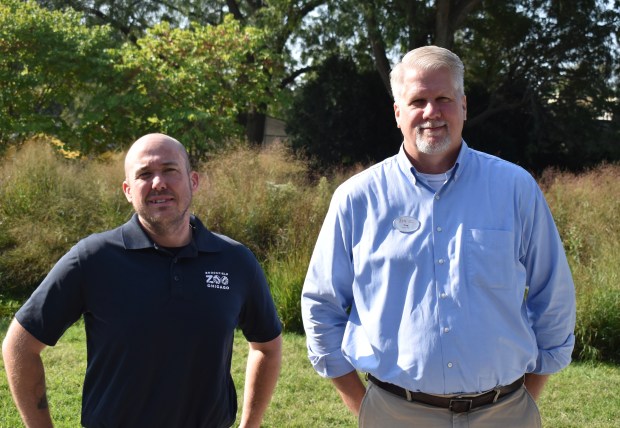Some rare birds living in cages on the second floor of Tropic World at Brookfield Zoo Chicago are never seen by the public.
However, those birds have a starring role in a project that aims to one day have them back in the U.S. territory of Guam.
Guam kingfishers, or sihek as the birds are known by Guam’s indigenous Chamoru people, went extinct in the wild due to invasive brown tree snakes introduced to the island during World War II.
Sihek were first listed under the Guam Endangered Species Act in 1982 and subsequently added to the U.S. Endangered Species List in 1984. It was officially recognized as being extinct in the wild following the last wild sighting in 1988.
That sparked an effort to save the species by breeding them in zoos and, one day, bringing them back to Guam. Now, 36 years later, it is happening.
Nine sihek including one from Brookfield Zoo Chicago were flown to the Palmyra Atoll and placed in pre-release aviaries on August 28 – the first step in a reintroduction effort.
If they do well there, some birds will be moved to Guam.
It’s quite a feather in the cap of Brookfield Zoo Chicago to be involved in the project.
Tim Snyder, vice president of zoological operations and programs, and Cody Hickman, associate director of avian care and conservation, are thrilled the zoo played a role to get the birds started on their homeward trek.
“For me, it’s knowing the zoo has been a part of this project for so long,” Hickman said. “We hold the largest population. We’ve helped hand-rear some of the chicks that are on Guam. It’s a great thing.
“To know we’re part of it is kind of why you start doing this job.”
It took until 2024 before the species could be re-introduced because of the invasive brown tree snake, which has no predators there and feasted on the kingfishers’ eggs along with the birds themselves, Hickman said.
There are still concerns, which is why the bird is slowly being reintroduced to the atoll.
The brown tree snake was introduced inadvertently near the end of World War II. A pregnant snake was likely coiled up in a crate brought in from New Guinea, Hickman said.
With no predators, there was nothing to prevent brown tree snakes from devouring the kingfisher species.
Among the nine birds released on Palmyra Atoll in August is a male bird named Yayas — pronounced Za-zass like “sass” — which originated at Brookfield Zoo Chicago.
Brookfield has the largest sihek population in the world, with 21 birds in its care.
Over the years, Brookfield Zoo Chicago has produced approximately 80 chicks for the recovery effort. The other birds released on Palmyra came from Cincinnati Zoo, Sedgwick County Zoo, Disney’s Animal Kingdom, and the National Aviary.
“You don’t have to train them how to migrate,” Snyder said, “but we have to train them how to be wild.”
Live prey is tossed into a box and it’s hoped the birds learn how to catch their own food, Hickman said: “It’s not in the wild, it’s not the same thing, but they get used to catching live food,” he said.
The reintroduction effort starting at the Palmyra Atoll is led by a global collaborative of conservationists who formed the Sihek Recovery Program, including representatives from the U.S. Fish & Wildlife Service, Guam Division of Aquatic and Wildlife, Zoological Society of London, The Nature Conservancy, Sedgwick County Zoo, AZA, and the International Union for the Conservation of Nature, with support from zoos like Brookfield Zoo Chicago.
It dates back to the 1980s, when an emergency rescue operation by the Association of Zoos and Aquariums and Guam Department of Agriculture brought 28 sihek into human care in hopes of preventing total extinction, according to a news release.
Currently, 127 adult Guam siheks are at 25 institutions, including the Brookfield Zoo.
The big question, of course, is will it work?
“It’s so variable,” Hickman said. “Certain species do better with introductions to the wild, where others don’t. Part of the reason they’re doing this, they want to make sure it works before they invest more in getting them back to Guam.”
Snyder said a “long term commitment” is needed, with the ultimate goal being bringing the brown tree snake population under control.
“Several islands near Guam had kingfishers. The bird can be introduced to those islands, potentially, but until they figure out how to control that snake on Guam, that will be the lynchpin,” Snyder said.
The breeding program was a challenge as the zoos had to learn how to safely transport the birds’ tiny eggs, often under an inch in size, Hickman said.
Birds have to be raised in a quarantine situation, lest they bring a non-native parasite or diseases to birds in Guam, Hickman said.
“We’ve been committed to this for decades now and we’re seeing the results of our hard work, which is really exciting,” Snyder said. “We’re trying to fix the problem humans caused.”
Tiny trackers will be fitted to the birds to enable the team to monitor their activity as they settle into their new habitat.
The releases will be repeated annually until 20 sihek have successfully established themselves as breeding pairs to one day raise the first wild-born sihek since the 1980s.
In the future, knowledge gained from this program may prove helpful.
“There are several related species throughout the Pacific area. So, if something happens on one of those islands, we have a bunch of information that can assist there,” Snyder said.
Steve Metsch is a freelance reporter for the Daily Southtown.




